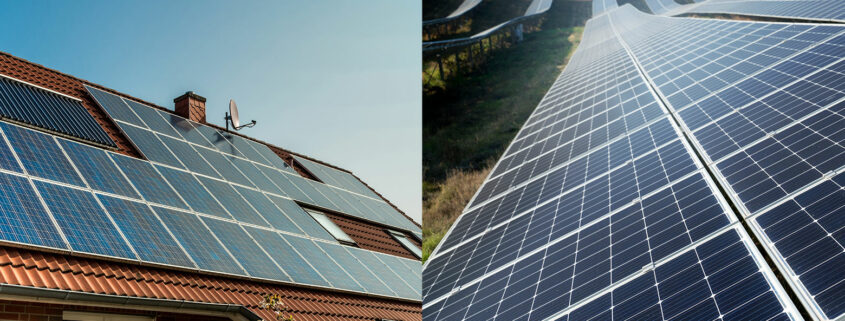In recent years, global interest in renewable energy and sustainability has propelled solar power into the limelight. Solar panels, the building blocks of solar energy systems, have become increasingly popular with both business owners and homeowners.
While the fundamental principles of harnessing sunlight remain the same, there are some key differences between solar panels designed for commercial use and their residential counterparts.
What are the differences between commercial vs. residential solar panels? Are they the same, but just different in size? Let’s learn more about solar power panels.
Quickly Reviewing the Science Behind Solar
Both commercial solar systems and residential solar panels operate on the photovoltaic (PV) principle, converting sunlight into electricity through semiconductor materials. The core components include solar cells, a metal frame, a glass casing, and wiring with inverters changing DC solar energy to AC energy.
Where Do You Put Your Solar Panels?
Before you get your hopes up or start spending money to bring solar energy to your property, you first must determine if you have the space and support required.
Depending on the integrity of the roof on your commercial or residential building, you may opt for mounting systems directly on your building. Keep in mind that solar panels are not only big but also heavy. Rooftop solar systems can be difficult for residential customers because of their size and weight.
Commercial Spacing
Commercial solar installations demand a robust array of hardware due to their larger scale. Mounting structures may include custom-designed frameworks for flat roofs or ground-mounted arrays in a parking lot or other part of the property, each to accommodate the commercial building’s unique set of needs.
A flat rooftop makes the installation process easier. Commercial solar power is usually attached with a bolted racking system, which is a heavy item securing the panels to a flat roof. Electrical wiring and distribution systems in commercial installations are designed to handle the increased complexity of larger solar systems and may include additional components like transformers for grid connections.
Residential Installations
Because there is less space to work with, residential systems are designed to be compact. They’re attached to racking, which is secured to the house with hardware that penetrates a sloped roof.
The mounting hardware, including roof anchors and rails, is chosen to ensure a secure fit without compromising the integrity of the residential roof. Inverters, such as string inverters or microinverters, play a pivotal role in converting the DC electricity generated by the panels into usable AC electricity for household consumption.
Incentives for Commercial and Residential Solar Systems
Solar energy systems are a fairly large investment, so let’s cover any financial relief you can find while you set up your system.
There are incentives like a federal solar tax credit for residential solar projects, but if you are a commercial customer, there’s even better news.
Not only is there a Federal Investment Tax Credit, but you may also qualify for special financing as well. This can spell out saving thousands of dollars in the long term with this lower-interest payment plan. Add that to your saved energy costs, and you have a great investment on your hands.
There’s a Size Component to Consider
Solar power systems come in varying sizes depending on whether it’s residential or commercial property.
Commercial solar panel systems are larger than residential ones. Usually, commercial solar panels have 96 cells that are 78 inches by 39 inches. This compares to the typical residential solar panel size of 72 cells, measuring 65 inches by 39 inches.
The larger panel size means commercial solar panels produce more solar energy. They’re slightly more efficient than typical residential panels by 1.5%.
Time Plays a Part in Residential and Commercial Solar Panel Installation
A commercial solar system has more solar panels than a residential one, so it makes sense that the installation time differs drastically between the two.
Commercial Installation
Expect installation for commercial solar projects to take months. Taking custom design and structural integrity into consideration can take several weeks. Add more time for regulations and permits that comply with local zoning and building codes.
Residential Timeline
Residential solar systems don’t take as long. There’s less space to fill on top of residential homes compared to commercial buildings. Not to mention that there is less intricate planning than with commercial solar panels.
Color Plays a Part in Efficiency
Depending on the manufacturing process of a photovoltaic system, colors are typically black or blue, but they can be personalized with other colors, too.
Black solar panels are monocrystalline, which are made from a single silicon crystal. They’re purer and, therefore, more efficient. Polycrystalline panels appear blue and are made from multiple silicon crystals.
Better Light Absorption
Black panels perform better in hot, sunny climates because they take in more solar energy. Panels with white backing will reflect sun rays.
TEMA is Your Solar Company
It’s critical to understand the differences between commercial vs. residential solar panels before starting your project. Solar as an energy source has lots of planning and money that goes into it, so it’s important to ask questions and make sure you know the answers.
Still have questions about commercial solar technology? Don’t hesitate to contact TEMA Roofing Services. We have more than 50 years of commercial roofing experience and would be happy to help with your next solar project.





